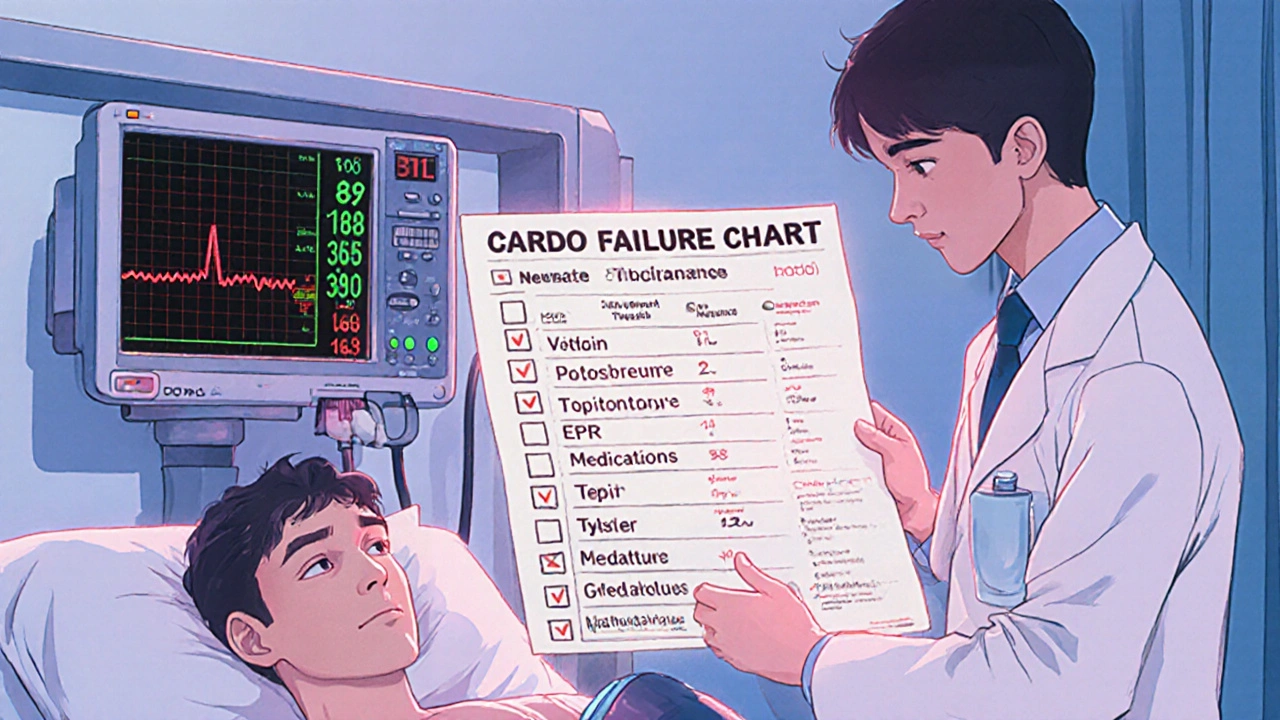Heart Failure Medication Dose Calculator
Sacubitril-Valsartan Dose Calculator
Calculate appropriate starting dose based on patient characteristics and renal function. Follows 2022 AHA/ACC/HFSA guidelines for heart failure medication monitoring.
Calculated Starting Dose:
No calculation yet
When you’re treating heart failure, getting the drug doses right is only half the battle - the other half is watching the patient closely. Heart Failure Medication Monitoring covers the lab tests, vital‑sign checks, and symptom reviews needed to keep each therapy safe and effective. This guide walks you through the core medication classes, highlights the extra steps needed for older adults, women, and non‑Caucasian patients, and gives you a practical checklist you can use at the bedside.
Why monitoring matters in guideline‑directed medical therapy (GDMT)
Guideline‑directed medical therapy for HFrEF now rests on four pillars: angiotensin receptor‑neprilysin inhibitors (ARNIs), beta‑blockers, mineralocorticoid receptor antagonists (MRAs), and sodium‑glucose cotransporter‑2 inhibitors (SGLT2i). The 2022 AHA/ACC/HFSA Guideline showed that patients who hit target doses of all four classes cut mortality by more than a third. Yet real‑world data reveal that fewer than 40 % of eligible patients reach those targets, largely because clinicians stop short of the required monitoring and titration steps.
Monitoring each GDMT pillar
ARNI (sacubitril‑valsartan) combines neprilysin inhibition with angiotensin‑II blockade is the first drug most providers start after stabilizing a patient on an ACE‑I or ARB. The key safety signals are blood‑pressure drops and worsening renal function. After the first dose, check systolic BP within 1-2 weeks; if it falls below 100 mm Hg, reduce the dose or pause until pressure recovers. Obtain serum creatinine and eGFR at baseline, then repeat at 2 weeks and again at 3 months.
Beta‑blocker (carvedilol, bisoprolol, metoprolol succinate) slows heart‑rate and reduces myocardial oxygen demand requires a stepwise titration to a resting heart rate of 50-60 bpm, if tolerated. Start low (e.g., carvedilol 3.125 mg bid) and double the dose every 2-4 weeks while watching for bradycardia (<50 bpm), worsening HF symptoms, or new‑onset atrial fibrillation. Record heart rate and blood pressure at each visit; if the resting rate stays ≥70 bpm despite maximal tolerated beta‑blocker, add ivabradine (see below).
MRA (spironolactone, eplerenone) blocks aldosterone‑mediated sodium retention is notorious for causing hyper‑kalemia. Check serum potassium and creatinine before starting, then again at 3-7 days, 1 month, and every 3 months thereafter. If potassium rises above 5.5 mmol/L, hold the drug and reassess diet, diuretic dose, and renal function. Women and non‑Caucasian patients show a higher incidence of hyper‑kalemia, so consider a lower initial dose (e.g., spironolactone 12.5 mg daily) in those groups.
SGLT2 inhibitor (dapagliflozin, empagliflozin) promotes glucosuria and reduces intravascular volume has the simplest monitoring schedule of the four. Verify eGFR ≥30 mL/min/1.73 m² before initiation; repeat renal function at 4 weeks. Look out for volume depletion-especially in patients over 75 years or those on high‑dose diuretics-by checking weight, orthostatic blood pressure, and signs of dehydration. Educate patients about genital mycotic infections; a 12 % incidence in trials signals the need for early topical treatment.
Ivabradine selectively inhibits the funny current (If) to lower heart rate without affecting contractility is added when heart rate remains >70 bpm despite optimal beta‑blocker dosing. Start 5 mg twice daily with meals; reduce to 2.5 mg twice daily in patients ≥75 years, those with conduction disease, or when combined with strong CYP3A4 inhibitors (which increase exposure 2.5‑3‑fold). Monitor ECG for QT prolongation and watch for angina‑related ischemia, which appeared 28 % more often in the SHIFT trial.
Special populations and extra monitoring steps
- Elderly (≥75 years): lower starting doses of ivabradine and ARNI; assess orthostatic vitals at each visit; use slower titration intervals (4‑6 weeks) for beta‑blockers.
- Women: sacubitril‑valsartan exposure can be 30 % higher; start at half the usual dose (e.g., 24/26 mg bid) and titrate more cautiously.
- Non‑Caucasian patients: higher risk of hyper‑kalemia on MRAs (15 % vs 9 % in White patients); use more frequent potassium checks (every 3 days for the first two weeks).
- Patients with chronic kidney disease (CKD): prioritize SGLT2i for renal protection; keep eGFR monitoring every 3 months; avoid high‑dose MRAs if eGFR <45 mL/min/1.73 m².
- Diabetics on SGLT2i: check for euglycemic diabetic ketoacidosis; obtain a baseline β‑hydroxybutyrate if the patient has a history of ketoacidosis.
Practical monitoring checklist
- Baseline labs: CMP (incl. potassium, creatinine), CBC, fasting glucose/HbA1c, BNP/NT‑proBNP.
- Day‑0-7: Check potassium (if MRA started) and renal function; record vitals and weight daily.
- Week 2: Review BP and HR after ARNI or beta‑blocker uptitration; adjust dose if systolic BP <100 mm Hg or HR <50 bpm.
- Month 1: Re‑check eGFR, potassium, and weight; assess for genital infections (SGLT2i) or dizziness (ivabradine).
- Every 3 months: Full metabolic panel, symptom questionnaire (NYHA class), and medication adherence review.
Comparison of monitoring intensity by drug class
| Medication class | Blood pressure | Heart rate | Potassium | Renal function (eGFR) | Special notes |
|---|---|---|---|---|---|
| ARNI | Baseline, 1‑2 weeks, then each dose change | Baseline, each visit | Not routine | Baseline, 2 weeks, 3 months | Watch for hypotension |
| Beta‑blocker | Every visit (dose titration every 2‑4 weeks) | Every visit; target 50‑60 bpm | Not routine | Baseline, then if symptomatic | Bradycardia or AV block warnings |
| MRA | Baseline, then as needed | Baseline only | Baseline, 3‑7 days, 1 month, q3‑6 months | Baseline, then if potassium >5.5 mmol/L | Hyper‑kalemia risk especially in Black patients |
| SGLT2i | Baseline, 4 weeks | Baseline only | Baseline only | Baseline, 4 weeks, then q3‑6 months | Volume depletion, genital infections |
| Ivabradine | Baseline, after any dose change | Every visit; keep HR 50‑70 bpm | Not routine | Baseline, then if renal decline | Avoid with CYP3A4 inhibitors; watch for angina |

Tools that make monitoring easier
Electronic health‑record (EHR) alerts are now standard in many hospitals. A simple rule-"If potassium >5.0 mmol/L, flag MRA dose hold"-cuts inappropriate discontinuations by 35 % (2024 ACC consensus pilot). Pharmacist‑led titration clinics have shown a jump from 28 % to 63 % of patients reaching target dose within six months. Remote‑monitoring platforms that feed daily weight, blood pressure, and symptom scores into a predictive algorithm flag decompensation up to three days before an office visit, reducing readmissions by roughly 30 % in high‑risk cohorts (CHAMPION trial).
Common pitfalls and how to avoid them
- “Pill counting” without dose titration: counting pills tells you adherence but not whether the patient is on a therapeutic dose. Pair counts with dose‑up titration logs.
- Skipping early potassium checks on MRAs: the first 3‑7 day window catches 80 % of hyper‑kalemia events; missing it often forces permanent discontinuation.
- Ignoring orthostatic vitals after ARNI: hypotension is the most common cause of early ARNI discontinuation; a 5‑minute standing BP after each dose change prevents unnecessary stops.
- Using ivabradine with strong CYP3A4 inhibitors: dose‑reduce to 2.5 mg bid or avoid altogether to sidestep toxic exposure.
How often should potassium be checked after starting an MRA?
Check serum potassium before the first dose, then again 3‑7 days later, at 1 month, and every 3‑6 months thereafter. If potassium exceeds 5.5 mmol/L, hold the drug and re‑evaluate.
Can I start an SGLT2 inhibitor in a patient with an eGFR of 35 mL/min/1.73 m²?
Yes, but use the reduced dose approved for renal impairment and monitor eGFR every 3 months. If eGFR falls below 30 mL/min/1.73 m², discontinue.
When should ivabradine be added to a beta‑blocker regimen?
Add ivabradine when the resting heart rate stays ≥70 bpm despite maximally tolerated beta‑blocker dose, provided the patient has sinus rhythm and no severe hypotension.
What monitoring is required for an ARNI in the first two weeks?
Check systolic blood pressure and renal function (creatinine, eGFR) at 1‑2 weeks after starting or uptitrating the ARNI. Adjust dose if systolic BP falls below 100 mm Hg or creatinine rises >30 %.
Are there gender‑specific dosing recommendations for ARNI?
Women tend to have higher drug exposure; start at half the usual dose (e.g., 24/26 mg twice daily) and titrate more slowly, monitoring blood pressure closely.


Comments (10)
Manish Verma October 25 2025
If you’re not tracking those labs every two weeks, you’re basically gambling with Aussie lives.
Jennie Smith October 26 2025
Wow, this rundown is a gold mine for anybody juggling heart‑failure meds on the ward.
I love how it spells out the exact windows for blood‑pressure and kidney checks – no more guessing games.
The gender‑specific dosing tip for ARNIs is especially eye‑opening; I hadn’t seen that highlighted before.
And the checklist idea? Perfect for busy nurses who need a quick visual cue.
Really appreciate the practical vibe – it’ll definitely make my next rounds smoother.
Greg Galivan October 28 2025
Look, man, the data’s solid – you can’t just wing it on labs. If you skip the 2‑week creatinine, you’re courting acute kidney injury, and that’s not a “friendly” approach. Get your act togather and follow the schedule, otherwise you’re endangering patients.
Anurag Ranjan October 29 2025
Nice points. Just add that every titration step should be logged in the chart, so you can track trends over time and spot any drift early.
James Doyle October 30 2025
When you’re navigating the labyrinth of guideline‑directed medical therapy for HFrEF, the precision of dose titration is tantamount to orchestrating a symphony of pharmacodynamic equilibria.
The four pillars-ARNI, beta‑blocker, MRA, and SGLT2i-each impose distinct hemodynamic and renal checkpoints that must be meticulously logged in the EMR.
First, secure a baseline echocardiographic ejection fraction and a comprehensive metabolic panel before initiating any uptitration cascade.
For ARNIs, the pharmacokinetic profile mandates a post‑dose systolic blood pressure measurement at 7‑10 days, with a repeat renal function test at day 14 to preempt acute kidney injury.
Beta‑blockers demand a heart‑rate target window of 50‑60 bpm; any deviation beyond 45 bpm should trigger a dose decrement, especially in the presence of concomitant calcium channel blockers.
The mineralocorticoid receptor antagonists carry a potassium toxicity vector that escalates exponentially when eGFR drops below 45 mL/min, necessitating potassium checks every 48 hours for the first two weeks.
SGLT2 inhibitors, while renal‑protective, impose a diuretic load that can precipitate intravascular volume contraction; monitor orthostatic vitals at each visit.
In elderly cohorts, pharmacodynamic sensitivity requires a 25 % reduction in initial dosing across all four classes, with titration intervals stretched to six‑week increments.
Women exhibit a higher plasma concentration of sacubitril‑valsartan; therefore, initiate at 24/26 mg bid and titrate only after confirming hemodynamic stability for a minimum of two weeks.
Non‑Caucasian populations demonstrate a heightened propensity for hyper‑kalemia on MRAs, which mandates a more aggressive potassium surveillance schedule, ideally every three days until stability is documented.
Don’t forget to reconcile over‑the‑counter NSAID use, as it can blunt the nephroprotective effects of the ARNI and SGLT2i combination.
Telemetry or at least a 12‑lead ECG should be obtained after any beta‑blocker dose escalation to rule out new‑onset QT prolongation.
If a patient exhibits worsening NYHA class despite optimized GDMT, consider adjunctive ivabradine only after confirming a resting heart rate above 70 bpm.
Maintain a dynamic checklist at the bedside-a laminated flowchart that prompts BP, HR, labs, and symptom review before each dose adjustment.
Finally, educate patients on self‑monitoring of weight, edema, and shortness of breath, because early detection of decompensation can truncate the cascade of hospital readmissions.
Edward Brown October 31 2025
All that “precision” sounds like a perfect cover for the pharma lobby pushing more drugs onto us. They want us to chase every target dose while the real issue – lifestyle, diet, stress – gets ignored. Keep an eye on who profits from these endless monitoring protocols.
ALBERT HENDERSHOT JR. November 1 2025
I hear your concerns, but the evidence base shows that systematic monitoring does save lives. 😊 Let’s focus on applying the guidelines responsibly while staying critical of external influences.
Cheyanne Moxley November 3 2025
Honestly, this feels like a lot to cram into a 30‑minute shift. Maybe we need a simplified version for junior docs – like a cheat sheet that flags only the red‑alert labs.
Kevin Stratton November 4 2025
Reducing complexity can still preserve depth; think of it as layering information – basic alerts first, then deeper analysis as needed. 🧐 Simplicity and thoroughness aren’t mutually exclusive.
Andrae Powel November 5 2025
Bottom line: consistent monitoring, dose adjustments based on concrete vitals, and patient education are the trio that drives down mortality. Keep the checklist handy, involve the multidisciplinary team, and never skip the potassium check after starting an MRA.